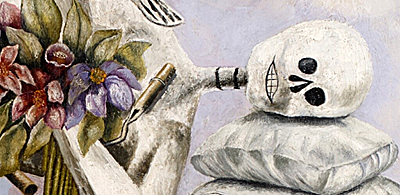Body Worlds: The Art of Plastic Corpses?
In 2004 the California Science Center in the Exposition Park of Los Angeles, presented Body Worlds: The Anatomical Exhibition of Real Human Bodies. In the words of the museum, “Thanks to the breakthrough process of plastination, more than 200 real human specimens are displayed to reveal an extraordinary new look inside the human body.”
As a realist artist I naturally have a great interest in human anatomy, and some of my artist friends urged me to attend the show, but the display is not without its detractors. The Los Angeles Times wrote a glowing review of the exhibit and hardly noted a controversy, saying only that 2% of exhibit attendees “have been uncomfortable.” The New York Times in its positive review of Body Worlds, also failed to see any controversy outside of the “eeeeuw” factor.
Actually, objection to Body Worlds is much deeper than the LA Times or New York Times will admit, with opponents including at least one major human rights organization.
Twenty years ago Gunther von Hagens (aka “The Plastinator), pioneered his plastination technique of preserving bodies by replacing natural body fluids with injected molten plastic. The plastic hardens and both preserves the tissues in lifelike color and enables the rigid corpses and organs to be displayed in any position. The first question to arise was whether this was art or science (personally I think it’s neither), but reservations only grew when the religious minded objected to what they call the “violation of human dignity” in using deceased human beings as an “art medium.”
However, the real controversy began when human rights activists started to point out that the bodies used in von Hagen’s “art” may have been the victims of political repression.
A January 2004 edition of Germany’s influential magazine, Der Spiegel, featured von Hagens on the cover under the headline, “Dr. Death.” The magazine reported that the good Doctor had purchased the bodies of executed Chinese prisoners, and that the corpses had bullet holes in their heads.
Karl Hafen, managing director of the Frankfurt based International Society for Human Rights said, “One must distinguish between artistic freedom and human rights.”
While von Hagens denied his employees had knowingly purchased the bodies of prisoners who had spent their last moments on their knees before being killed by a bullet to the back of the head, he did say “The likelihood is very slim, but I cannot rule it out.”
Nevertheless, von Hagens was forced to return seven Chinese bodies for “proper burial” when he could not prove they had not been executed by the Communist regime. Still, a proper burial while injected full of plastic seems an odd thing.
Controversy continues to follow von Hagens. This month Russian courts have ordered a retrial for Dr. Vladimir Novosyolov, accused of trying to ship 56 “unclaimed” cadavers and 448 brains to von Hagens’ Institute of Plastination in Heidelberg Germany. While Dr. Gunther von Hagens insists all cadavers in his exhibitions come from people who have voluntarily donated their bodies – one still has to wonder.




